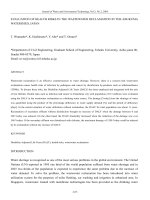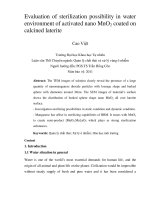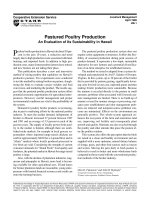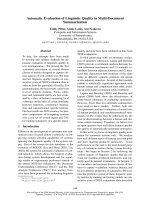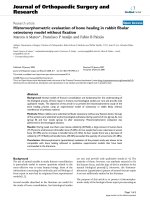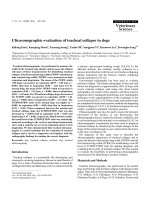Evaluation of diagnostic test in emerging carbapenem resistant gram negative bacilli in patients admitted to tertiary care centre in north India
Bạn đang xem bản rút gọn của tài liệu. Xem và tải ngay bản đầy đủ của tài liệu tại đây (244.07 KB, 8 trang )
Int.J.Curr.Microbiol.App.Sci (2019) 8(4): 2339-2346
International Journal of Current Microbiology and Applied Sciences
ISSN: 2319-7706 Volume 8 Number 04 (2019)
Journal homepage:
Original Research Article
/>
Evaluation of Diagnostic Test in Emerging Carbapenem Resistant Gram
Negative Bacilli in Patients admitted to Tertiary Care Centre in North India
Munesh Kumar Sharma1*, Dakshina Bisht1 and Shekhar Pal2
1
Department of Microbiology, Santosh Medical College, Ghaziabad, NCR Delhi, India
2
Department of Microbiology, Doon Medical College, Dehradun, India
*Corresponding author
ABSTRACT
Keywords
β-lactam antibiotics,
Carbapenems,
Metallo beta
lacatamases,
Double disc
synergy test,
Meropenem
Article Info
Accepted:
17 March 2019
Available Online:
10 April 2019
Carbapenem antibiotics are very often used against multidrug resistant strains clinically
troublesome pathogens which developed and proved that the resistance and metallo-βlactamases (MBL) production were a disaster in treating infections. The identification and
detection of MBL-producing bacterial strains were having crucial importance for the
prevention of nosocomial infections. Therefore the present study was undertaken for
screening MBL production Gram Negative bacteria. One hundred twenty two 122
consecutive Non-repetitive isolates of gram negative bacilli clinical isolates were subjected
to susceptibility testing by disc-diffusion test on Mueller Hinton Agar. Meropenem
resistant (MR) strains MBL production among MR stains were further screened by
Meropenem- EDTA combined disc synergy test (M-CDST) and Meropenem-EDTA
double-disc synergy test (M-DDST). A total of 31 isolates showed resistance to
Meropenem which were screened and 29 (93.55%) isolates gave positive result by MDDST whereas 27 (87%) were MBL producers by M-CDST. Escherichia coli isolates
recorded highest as MR strains were identified. For the treatment, implementation of
effective infection control and prevention of nosocomial dissemination used the procedure
for detection and identification of carbapenem resistant by most reliable method for study
of MBLs produced isolates. The more effective method was M-DDST in comparison of
other method as M-CDST.
Introduction
The emergence of carbapenem resistant
strains among gram negative bacteria is a
notable threat. Clinically relevant bacterial
species detected often resistant to different βlactam antibiotics, including the antibiotics
which
cover
extended
spectrum
cephalosporins, but rarely to carbapenems
(Chu et al., 2001). Among the B-lactams
drugs, carbapenems were potent agents for
treatment of serious infections by gramnegative bacteria. Their broad spectrum
activity and resistance to hydrolysis by most
B-lactamases, including the extendedspectrum B-lactamases (ESBL) (Bush et al.,
1995). Carbapenems antibiotics are the drug
of choice for treatment of extended spectrum
2339
Int.J.Curr.Microbiol.App.Sci (2019) 8(4): 2339-2346
beta lactamase (ESBL) producing gram
negative bacterial infections where the
penicillin and other group cephalosporin
antibiotics were resistant. Resistant Gram
negative bacterial isolates are the important
causative agents for urinary tract infections,
bloodstream infections, healthcare-associated
pneumonia, intra-abdominal infections and
ventilator associated pneumonia. The
increasing
resistance
of
Carbapenem
antibiotics in family Enterobacteriaceae and
other group of Gram negative bacilli were a
significant
challenge
with
increasing
prevalence. So Gram negative bacteria
recognized resistance against different group
of antibacterial drugs Worldwide. (NNIS,
2004)
However, in past few years resistance to
carbapenems
due to production of
carbapenemases
have
been
reported.
Carbapenemases may be defined as betalactamases that significantly hydrolyze at
least imipenem or meropenem. Most
significant involved in acquired resistance are
of Ambler molecular classes A, B and D.
Class B or the Metallo–beta-lactamases
(MBLs) enzymes are the most significant
carbapenemases (Nordmann and Poirel, 2002;
Deeba Bashir et al., 2011; Walsh et al., 2005).
Carbapenemases especially MBLs due to
transferrable in character are the most feared
because it can hydrolyse almost all antibiotics
including carbapenem antibiotics. So the
study was conducted the detection of the
carbapenem antibiotics resistance in gram
negative bacilli isolates from different clinical
specimens by phenotypic methods which may
help to screen the population in hospital
environment to guide effective empirical
therapy.
Materials and Methods
A prospective study was carried out on 122
non repetitive gram negative bacilli isolates
which has been isolated various clinical
specimens from hospitalized patients. The
study was approved by institutional ethics
committee. The isolates were identified as per
standard conventional methods as per CLSI
guidelines 2010 (CLSI, 2010) in which
incorporated the antibiotics were ampicillin
(10 mcg), amocicillin/clavulenic acid (30
mcg) gentamicin (10 mcg), amikacin (30
mcg), netilmicin (10 mcg), cefotaxime (30
mcg), ceftriaxone (30 mcg), ceftazidime (30
mcg), cefepime (30 mcg), CIprofloxacin (5
mcg), meropenem (10 mcg), cefoperazone/
sulbactam
(75/10
mcg),
piperacillin/
tazobactum (100/10 mcg) with polymyxin B
(300 Units), tigecycline (15 mcg) and these
were tested for in-vitro Carbapenem
resistance and then tested to see MBL
production in the bacterial isolates.
Isolated Gram negative bacilli identified from
different clinical specimens which were
resistant to carbapenem group of antibiotic as
Meropenem. The gram-negative bacilli were
showing the resistance for carbapenem
antibiotic on routine screening was confirmed
for presence of MBL production. Briefly,
Muller-Hinton agar used for antibiotic
susceptibility testing.
The combined disc and double disc synergy
test methods were used to confirm above
resistance mechanisms for MBL production
(Lee et al., 2003).
Meropenem-EDTA combined disc synergy
test (CDST-Meropenem)
Disks of Meropenem (10mcg, Himedia) and
Meropenem with ethylene diamine tetraacetic
acid, (EDTA) (10mcg + 750 mg, prepared in
house) for MBL detection were used.
Inoculated plates were incubated for 16-18
hours at 37 ºC. If the increase in inhibition
zone with Meropenem- EDTA disc was ≥7
mm than the Meropenem disc alone then it
was considered as MBL positive.
2340
Int.J.Curr.Microbiol.App.Sci (2019) 8(4): 2339-2346
Meropenem-EDTA Double Disc Synergy
Test (DDST-Meropenem)
A Meropenem (10ug) disc was placed 20 mm
center to center from a blank disc containing
10ul of 0.5M EDTA (750ug). Inoculated
plates were incubated for 16-18 hours at 37ºC.
If enhancement in zone of inhibition between
Meropenem and EDTA disc which was
considered as positive for MBL production.
Results and Discussion
A total of 122 consecutive Non-repetitive
isolates of gram negative bacilli obtained
from various clinical samples were included
in the study out of which 46 were isolated
highest from pus, 32 follow urine, 21 sputum,
15 blood, 3 Urine Catheter tip, 2 Endotracheal
Tube, 2 fluids and 1 from otitis media as
depicted in Table 1.
Out of 122 Gram Negative Bacilli isolates
were highest in pus 46 (37.7 %). Out of 31
carbapenem resistant isolates in pus identified
highest isolates 11 (35.48%), shown in Table
1. In 31 carbapenem resistant isolates, highest
isolates were recorded in surgical ward
12(39%), followed medicine 7(23%), ICU
5(16%), OBS/Gynae 4(13%), Orthopedic
2(6%) and Paediatric 1(3%) shown in Chart
no 1. Antimicrobial susceptibility in MBL
producing bacterial strains showed resistant to
different
antibiotics
as
group
of
cephalosporins,
aminoglycosides,
fluoroquinolones, carbapenem drug as
meropenem, and seen 100% sensitive for
Polymyxin B, colistin followed 46%
Tigecycline which were showed in Table 2. In
Gram Negative Bacilli out of 31 carbapenem
resistant highest isolate was Escherichia coli
8(25.81%)
followed
Pseudomonas
aeruginosa and Acinetobacter baumannii
6(19.35%), Klebsiella pneumoniae 4(12.9%),
Klebsiella oxytoca 2(6.45%), Proteus
mirabilis 2(6.45%), Other GNB 2(6.45%) and
Citrobacter
freundii
1(3.23%).
MBL
detection test showed positive, for MBL
production higher by DDST (29 isolates) and
by CDST (27 isolates), shown in Table 3.
Infections caused by multidrug resistant gram
negative bacterial where Carbapenem
antibiotic proved most potent agents for
treatment. MBL production is a most
important mechanism to hydrolyse the
Carbapenem antibiotics which emerged as the
Carbapenem resistance. As per the therapeutic
significance these bacterial isolates in study
were also showing resistance for many other
antibiotic
groups
like
beta-lactams,
aminoglycosides, fluoroquinolones and out of
these, options left for therapy are use of
Polymixin B and Colistin antimicrobial agent
which carry potential toxicity (Gupta et al.,
2012; Jesudason et al., 2005; Gupta et al.,
2006). In the study highest number of
resistance strains found from surgical
department as similar (Nagaraj et al., 2012)
except the other found in intensive care unit
(Gupta et al., 2006; Mahajan et al., 2011;
Sinha et al., 2007). The continuation in
increasing prevalence of MBL producing
strains has proved to be a clinical disaster and
due to unnoticed spread within hospital or
institution may turn to serious challenge for
infection control management. And MBL
producing strains may participate in
horizontal MBL gene transfer to other
pathogens in the hospital settings due to
intrinsic capability of MBL producing strains.
As Early detection of MBL producing
bacteria in infections is need to treat
appropriate with in time limit which might
reduce the mortality when patient stay in
hospital (Arakawa et al., 2000). MBL
producing strain screening methods had been
employed in different studies but due to no
standard guidelines CLSI for detection of
MBL which not laid Performance standards
(Behera et al., 2008). In the present study we
had used two conventional phenotypic tests
2341
Int.J.Curr.Microbiol.App.Sci (2019) 8(4): 2339-2346
for detection of MBL production as
Meropenem-EDTA Combined Disc Test
(CDST) and Meropenem-EDTA Double Disc
Synergy Test (Meropenem-DDST). Although
to see the Meropenem resistance by E test is
also used for MBL detection but CDST and
DDST are comparable to it and are also
simple, reliable, inexpensive and reproducible
(Yan et al., 2004). We had found that with
Meropenem-EDTA DDST, the positives and
negatives properly but with CDST it may be
due to subjective variations with calculation
for preparation of standard reagents. DDST
identification was done with discriminating
the true synergism. So, the DDST method
using Meropenem-EDTA had good impact
over CDST. As per the finding is in
accordance with other studies which had
found DDST to be one of the most sensitive
technique for detecting MBL in comparison
of CDST.
Table.1 Sample wise distribution of clinical isolates with carbapenem resistance
Specimens
Clinical Isolates [no. (%)]
Pus
Urine
Sputum
Blood
Urine Catheter Tip
ET tube
Fluid
Otitis media
Total
46 (37.7)
32 (26.23)
21(17.21)
15(12.3)
3(2.46)
2(1.64)
2(1.64)
1 (0.82)
122
Carbapenem Resistant isolates [no.
(%)]
11(35.48)
8 (25.81)
5(16.13)
3(9.68)
2(6.45)
1(3.23)
1(3.23)
0
31
Table.2 In vitro available susceptibility of MBL and Non MBL producing GNB isolates
Antibiotics
Ampicillin
Amoxicillin/Clavulanic Acid
Cefotaxime
Ceftriaxone
Ceftazidime
Cefepime
Piperacillin/Tazobactam
Gentamicin
Amikacin
Neticillin
Ciprofloxacin
Cefoperazone/Sulbactam
Meropenem
Tigecycline
Colistin
Polymyxin B
Number of Non MBL Strain
(n=122)
30
78
112
114
108
116
120
94
114
94
114
92
122
122
122
122
2342
Percentage of MBL Strains
(n=36)
0
0
0
0
0
0
0
0
0
0
0
0
0
46
100
100
Int.J.Curr.Microbiol.App.Sci (2019) 8(4): 2339-2346
Table.3 Carbapenem resistant isolates with difference between MBL detection tests
Microorganism
Escherichia coli
Pseudomonas aeruginosa
Acinetobacter baumannii
Klebsiella pneumoniae
Klebsiella oxytoca
Proteus mirabilis
Other GNB
Citrobacter freundii
Carbapenem
Resistant Isolates
8 (25.81)
6 (19.35)
6 (19.35)
4 (12.9)
2 (6.45)
2 (6.45)
2 (6.45)
1 (3.23)
31
MBL detection test
By DDST
By CDST
[n=29 (%)]
[n=27 (%)]
8(27.59)
7 (23.93)
6(20.69)
6 (22.22)
5(17.24)
5(18.52)
4(13.79)
3 (11.11)
2(6.9)
2(7.41)
2(6.9)
2(7.41)
1(3.45)
1(3.70)
1(3.45)
1(3.70)
Chart.1 Ward-wise distribution of Meropenem resistant 31 Gram Negative bacterial isolates
2343
Int.J.Curr.Microbiol.App.Sci (2019) 8(4): 2339-2346
Fig.1 Showing antibiotic susceptibility testing in phenotypic method of Meropenem resistant
strains for detection of metallo-β-lactamase producers. (A) Meropenem antibiotic resistant (B)
Showing Combined Disc Synergy Test (Meropenem antibiotic incorporated EDTA disc) (C)
Showing Double Disc Synergy Test (one disc Meropenem and other disc with EDTA) (D)
Showing Blank disc
In India prevalence ranging from 14 to 20%
has been reported in studies MeropenemDDST identified most sensitive test for
detection of MBL production and hence
Meropenem disc is a better option for
screening MBL (Sinha et al., 2007; Sinha et
al., 2013). In our study, out of 122 Gram
Negative bacilli strains 31 (25.41%)
carbapenem resistant were prevalent. And out
of 31 carbapenem resistant isolates DDST
detected higher number of MBL producers 29
(93.55%) than CDST 27 (87%). In Figure 1 in
vitro antibiotic susceptibility testing showing
organism resistant to 10µg Meropenem (A),
combined disc synergy test showing ≥7mm
increased size of zone of inhibition in
Meropenem with EDTA combined disc (B),
Double
disc
synergy
test
showing
enhancement of zone of inhibition between
Meropenem and EDTA disc (C) and blank
disc showing no zone of inhibition for
microorganism which was used as a control
(D).
In conclusion, metallo-beta lactamases
producing GNB isolates disseminated
worldwide. So study finds that antibiotic
surveillance should be at regular interval in
hospital settings. And strict Antibiotic policy
enforcing judicious use of antibiotics in the
different clinical departments for effective
control of carbapenem resistant bacteria either
patient stay is longer. There is a importance to
introduce a simple, cheap, reliable and
reproducible screening tests for early
detection and identification of MBLproducing GNB in routine diagnostics
laboratories. So we advise that in diagnostic
2344
Int.J.Curr.Microbiol.App.Sci (2019) 8(4): 2339-2346
procedure use additional EDTA disc
(750μgm/ml) on routine AST plates and also
screen by Meropenem- DDST method for
MBL producers.
Acknowledgement
I will be more thankful to technical staff for
technical support and the M.Sc. medical
students from microbiology department of
Santosh Medical College.
References
Arakawa Y, Shibata N, Shibayama K,
Kurokawa H (2000). Convenient test for
screening
metallobetalactamases
producing gram negative bacteria using
thiol compounds. J Clin Microbiol
38:40-3.
Behera B, Mathur P, Das A, Kapil A, Sharma
V (2008). An evaluation of four
different phenotypic techniquesfor
Detection
of
metallo-β-lactamase
producing Pseudomonas aeruginosa.
Ind J Med Microbiol 26(3): 233-7.
Bush K, Jacoby GA, Medeiros AA (1995). A
functional classification scheme for blactamases and its correlation with
molecular structure. Antimicrobial
Agents Chemother 39:1211-33.
Chu Y W, Shah M A, Houang E T S,
Palepou M F I, Lyon D J, Woodford N
et al., (2001). IMP-4 a novel metallo βlactamase
from
nosocomial
Acinetobacter spp. Collected in Hong
Kong between 1994 and 1998.
Antimicrob. Agents Chemother 45: 710714.
Clinical and Laboratory Standard Institute.
Performance standards for antimicrobial
susceptibility
testing;
Twentieth
information supplement, document
M100-S20. Warne, PA: Clinical
Laboratory Standard Institute 2010, 45110.
2345
Deeba bashir, Manzoor Ahmad Thokar,Basir
Ahmad Fomda, Gulnaz Bashir, Danish
Zaroor, Shabir Ahmad and Abubaker S.
Toboli (2011). Detection of Metallo-βlactamase
(MBL)
producing
Pseudomonas aeruginosa at a tertiary
care hospital Kashmir. Afr J Microbiol
Res 5(2): 164-172.
Gupta E, Mohanty S, Sood S, Dhawan B
(2006).
Emerging
resistance
to
Carbapenems in a tertiary care hospital
in north India. Indian J Med Res 124(1):
95-8.
Gupta V, Sidhu S, Chander J (2012).
Metallo-β- lactamase producing nonfermentative gram-negative bacteria:
An increasing clinical threat among
hospitalized patients. Asian Pacific J
Trop Med 5(9):718-21.
Jesudason MV, Kandathil AJ, Balaji V
(2005). Comparison of two methods to
detect carbapenemase and metallo-βlactamase production in clinical
isolates. Indian J Med Res 121:780-3.
Lee K, Lim YS, Yong D, Yum JH, Chong Y
(2003). Evaluation of the Hodge test
and the imepenem-EDTA double-disk
synergy test for differentiating metalloβ-lactamase producing isolates of
Pseudomonas spp. and Acinetobacter
spp. J clin Microbial 41:4623-9.
Mahajan G, Sheemar S, Chopra S, Kaur J,
Chowdhary D, Makhija S K (2011).
Carbapenem resistance and phenotypic
detection of carbapenemases in clinical
isolates of Acinetobacter baumannii.
Indian J Med Scienc 65(1):18-25.
Nagaraj S, Chandran SP, Shamanna P,
Macaden R (2012). Carbapenem
resistance among Escherichia coli and
Klebsiella pneumoniae in a tertiary care
hospital in south India. Indian J Med
Microbiol 30(1): 93-95.
National Nosocomial Infections surveillance
(NNIS) System Report, data summary
from January 1992 through June 2004,
Int.J.Curr.Microbiol.App.Sci (2019) 8(4): 2339-2346
issued October 2004. Am J Infect
Control 2004; 32: 470-85.
Nordmann P, Poirel L (2002). Emerging
carbapenemases in gram negative
aerobes. Clin. Microbiol Infect 8: 321333.
Sinha M, Srinivasa H (2007). Mechanisms of
resistance
to
carbapenems
in
meropenem-resistant
Acinetobacter
isolates from clinical samples. Indian J
Med Microbiol 25(2):121-125.
Sinha N, Agarwal J, Srivastava S, M Singh
(2013). Analysis of carbapenem-
resistant Acinetobacter from a tertiary
care setting in north India. Indian J Med
Microbiol 31(1):60-63.
Walsh TR, Toleman MA, Poirel L, Nordman
P (2005). Metallo-β-lactamases: the
quiet before storm? Clin Microbiol Rev
18: 306-325.
Yan JJ, Wu JJ, Tsai SH, Chuang CL (2004).
Comparison of the double disk,
combined-disk, and E Test methods for
detecting metallo-β-lactamases in gramnegative bacilli. Diagn Microbiol Inf
Dis 49: 5-11.
How to cite this article:
Munesh Kumar Sharma, Dakshina Bisht and Shekhar Pal. 2019. Evaluation of Diagnostic Test
in Emerging Carbapenem Resistant Gram Negative Bacilli in Patients admitted to Tertiary Care
Centre in North India. Int.J.Curr.Microbiol.App.Sci. 8(04): 2339-2346.
doi: />
2346
